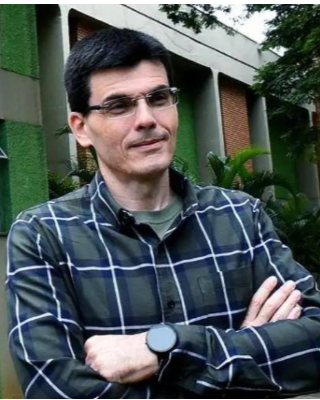
Cargo: Professor Titular
PhD University of Campinas
Dep. BIOLOGIA ESTRUTURAL E FUNCIONAL, IB, Unicamp, Campinas, SP
alroliv@unicamp.br
Graduate at Ciências Biológicas from Universidade Estadual Paulista Júlio de Mesquita Filho (1993), master's at General Biology from Universidade Estadual de Campinas (1996) and ph.d. at General Biology from Universidade Estadual de Campinas (1999). Has experience in Morphology, focusing on Anatomy, acting on the following subjects: c57bl6j, nervo ciático, tubulização, regeneração nervosa and pedegeneração.
Currently, in terms of regenerative rehabilitation, the Laboratory of Nerve Regeneration (LRN), which I coordinate, works on different fronts that are complementary to each other. Among the components of the repair process, measures that fall into two large groups named regenerative medicine and rehabilitation are contemplated. In the first (regenerative medicine) one can list the use of therapeutic elements such as stem cells, matrices/ scaffolds, drugs, and optimization technologies; in the second (rehabilitation), the use of physical activities, in different environments and with different protocols, is contemplated, according to the clinical condition in question. Regarding the application of treatments of cellular origin, the LRN has focused its efforts on using stem cells, which are a cell type characterized by two great properties: 1) self-renewal and 2) differentiation into different cell types. In this context, we have stem cells from different lineages, such as those of human embryonic and mesenchymal origin, the latter being obtained from different sites, such as adipose tissue and dental pulp. Cells of adipose origin are obtained, for example, from material dispensed in liposuction procedures, thanks to partnerships established with physicians and other healthcare professionals. Proof of the promising effect of cell therapies, in recent years, the LRN has published, in several journals, the beneficial effects of this type of treatment (Araújo et al., 2017, Spejo et al., 2018, Mozafari et al., 2018, Castro et al., 2020). Furthermore, in LRN, the use of cells related to the immune system (cell therapy by lymphocytes) in models of nerve damage is also being researched (Bombeiro et al., 2016, 2020). Associated or not with cell therapy, the LRN investigates the applicability of different types of matrices/frameworks. Resulting from an interdisciplinary and multidisciplinary field, tissue engineering has specialized in the production of technologies that help in the three-dimensional tissue repair process. In the laboratory context, after root avulsion or axotomy of a mixed nerve, a structure is needed that allows the end-to-end reimplantation or junction (coaptation) of stumps effectively, that is, creating an environment that not only reconnects nerve stumps at the injury site, but that allows physiological and biological processes of self-repair, always aiming at functional reestablishment.
I have been working, over the years, in undergraduate courses for the courses of Physical Education, Medicine, Medical Physics, Pharmacy and Speech Therapy. In graduate school I work in the discipline of cell culture - NC712.
Freria, C.M.; Zanon, R.G.; Santos, L.M.B.; oliveira, A.L.R.; Major histocompatability complex class I expression and glial reaction influence spinal motoneuron synaptic plasticity during the course of experimental autoimmune encephalomyelitis. Journal of Comparative Neurology (1911), v.518, p. 990-1007, 2010 [ doi:10.1002/cne.22259 ]
Barbizan, Roberta; De Castro, M. V.; Rodrigues, A. C.; Barraviera, B.; Ferreira Junior, R. S.; oliveira, Alexandre L.R.; Motor Recovery and Synaptic Preservation after Ventral Root Avulsion and Repair with a Fibrin Sealant Derived from Snake Venom. Plos One, v.8, p. e63260-, 2013 [ doi:10.1371/journal.pone.0063260 ]
Benitez, S. U.; Barbizan, Roberta; Spejo, A. B.; Ferreira Junior, R. S.; Barravieira B; Goes, A; oliveira, A. L. R.; Synaptic plasticity and sensory-motor improvement following fibrin sealant dorsal root reimplantation and mononuclear cell therapy. Frontiers in Neuroanatomy, v.8, p. 1-, 2014 [ doi:10.3389/fnana.2014.00096 ]
Chiarotto, G. B.; Nardo, G.; Trolese, M. C.; Franca Junior, M. C.; Bendotti, C.; oliveira, Alexandre Lr; The Emerging Role of the Major Histocompatibility Complex Class I in Amyotrophic Lateral Sclerosis. INTERNATIONAL JOURNAL OF MOLECULAR SCIENCES, v.18, p. 2298-, 2017 [ doi:10.3390/ijms18112298 ]
Chiarotto, G. B.; Cartarozzi, L.; Perez, M.; Biscola, N.; Spejo, A. B.; Gubert, F.; Franca Junior, M. C.; Otero, R. M.; oliveira, Alexandre L.R.; Tempol improves neuroinflammation and delays motor dysfunction in a mouse model (SOD1G93A) of ALS. Journal of Neuroinflammation, v.16, p. 218-, 2019 [ doi:10.1186/s12974-019-1598-x ]